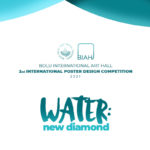2021 2nd BOLU INTERNATIONAL ART HALL INTERNATIONAL POSTER DESIGN COMPETITION
About Theme
Water is one of the most widely distributed substances to be found in the natural environment and constitutes the earth’s oceans, seas, lakes, rivers and underground water sources. The total amount of water on Earth is approximately 1.4 billion cubic kilometers. Although 75% of the Earth is covered by oceans in the form of sea water, only 2.5% of all water on Earth is freshwater. The freshwater on Earth is in the form of ice in glaciers, the polar ice caps or as underground water in aquifers. Water never sits still, since there is an existing water cycle; the amount of water does not diminish, water moves from one place to another and from one to another.

On land, water evaporates from the ground, mainly from soils, plants (i.e., evapotranspiration), lakes, and streams. In fact, approximately 15% of the water entering the atmosphere is from evaporation from the Earth’s land surfaces and evapotranspiration from plants. Evaporation helps to cool the Earth’s surface and the lower atmosphere, and to provide water to the atmosphere in order to form clouds.

Source: U.S. Geological Survey ( https://water.usgs.gov/edu/earthwherewater.html), TSKB Economic Research
Which Sectors Drive Water Consumption?
Energy sector accounts for the lion’s share of water use in the commercial and industrial sectors with a share of approximately 75%. Producing energy consumes a great deal of water, with water used at every stage of energy production, including pumping oil, removing pollutants in power plants, generating steam to run turbines, and in cooling power plants. According to the World Energy Outlook (WEO, 2018), in 2016, the energy sector withdrew around 340 billion cubic meters (bcm) of water and consumed roughly 50 bcm of water. The energy sector is responsible for the majority of water extraction, with the once through cooling systems in coal-fired power generation accounting for over one third of energy-related water extraction. Primary energy production is responsible for more than two-thirds of water consumption, with the production of fossil fuels and biofuels responsible for roughly one third. In recent years, the extraction of shale gas oil wells has involved hydraulic fracturing, which requires significant volumes of water and causes additional greenhouse gas emissions compared to conventional gas wells.
Approximately five million gallons of water are required to drill and frack a well, the equivalent of 1,000 water truck movements (Accenture, 2012). The textile industry is known to be another intense consumer of water in the world. According to the U.S. Environmental Protection Agency (EPA), it takes 10,000 liters of water to produce a single pair of jeans3. Another water user industry is the meat production and beverage industry. According to the Water Footprint Network⁴, nearly 130 liters of water is needed to produce the ingredients to make a single cup of coffee. The global automotive industry is another major consumer of water for various production processes. According to some estimates, producing a car uses over 39,000 gallons of water.
Water in households is mainly needed for cleaning, washing and personal hygiene. Water use in households varies enormously between different regions: while around 20 liters per capita and day are used in the rural arid regions in Africa, each person in the U.S. consumes an average of almost 300 liters per day.
About Water Scarcity!
An ecosystem includes all living things (plants, animals and organisms), as well as their interactions with each other, and with their non-living environments (weather, earth, sun, soil, climate, atmosphere). Water is the most important component of an ecosystem, and is named as the power of the ecosystem. Water need in the ecosystem is also a vital component of the global water use.
Water is essential for all socio-economic development and for maintaining healthy ecosystems. Even though the amount of water on Earth has remained steady over the years, as population and the need in the groundwater and surface water for domestic use, agricultural use and industrial use increase, the pressure on water resources deepens. Thus, imbalances between supply and demand creates a global issue named water scarcity. Water scarcity, an international term, is the point at which the total impact of all users strikes on the supply or the quality of water under viable institutional arrangements to the extent that the demand by all sectors cannot be fully satisfied. Water scarcity involves water stress, water shortage or deficits, and water crisis.
Water scarcity can be separated into two: physical (absolute) water scarcity and economic water scarcity, where physical water scarcity is a result of inadequate natural water resources to supply a region’s demand, and economic water scarcity is a result of poor management of the sufficient available water resources. Although water scarcity often occurs in areas with low rainfall, human activities add to the problems in particular areas with high population density, tourist inflow, intensive agriculture and water demanding industries.
According to a study conducted by Massachusetts Institute of Technology (MIT) researchers (Schlosser et al., 2014), approximately 50% of the world’s projected 9.7 billion people is projected to bear moderately stressed water resource conditions by 2050. Recently, water vulnerability is considered to be a growing threat for regions with uncertain political futures.
According to an article by Julie C. Padowski (2015), water vulnerability is not only a concern but a fact in 119 low-income countries⁸. The results of the study show that water vulnerability was identified as a big issue in twenty-five countries. Jordan, Djibouti and Yemen were found to be the most vulnerable countries. Vulnerability arises from an overall lack of water resources and management issues and can often be reduced by economic investment (such as, desalination, importing water from distant locations). The study suggests that institutional issues, especially corruption, are the most common factors generating water supply vulnerability, affecting approximately 40% of the low-income nations. A lack of precipitation does not necessarily equate with water supply vulnerability. Another striking result of the study is that water vulnerability is becoming a crucial issue as the population increases.
What Actions are Needed to Reduce Water Scarcity?
- Reducing water scarcity is a goal for many countries. Water scarcity can be reduced mainly with synchronized public-private actions. The main actions would be to take collective measures and create awareness to improve savings in water consumption. Another possible action that the Government could take is to draft appropriate legislation and incentives aimed at increasing water efficiency in agriculture and industry.
- Population intensity is another reason for water scarcity. Water scarcity could be reduced by migration to low populated areas, which could be performed by moving industrial employment from populated regions to non-populated regions.
- The use of sprinkler irrigation method and drip irrigation method may be increased to boost efficiency. As a rule of thumb, the sprinkler irrigation is considered to use 70% less water and the drip irrigation method 90% less than conventional methods.
- Climate change and water scarcity are two phenomena, which will cause some of the biggest challenges to the economies. These two have a reciprocal relationship, identified by the Intergovernmental Panel on Climate Change (IPCC), in which, “water management policies and measures may influence greenhouse gas (GHG) emissions.” Since one of the largest industries to use water intensively is the energy sector, the savings in water use can be carried out by producing alternatives to thermal power plants, such as bio-energy crops, hydroelectric and solar power plants.
- The improvement of water networks and pipelines is likely to be a key focus, as will water treatment and sanitation plants. Meanwhile, the municipalities need to increase investment on reducing theft and loss ratios.
- Water sewage and wastewater treatment is an integral part of the fight against water scarcity. In order to achieve holistically managed ecosystems, governments and communities should operate sewage treatment plants while clean energy producers use wastewater to fertilize algae and other biofuel crops.
Regarding household water use, it is imperative that governments, households, private sector players and municipalities invest more in education on the water scarcity problem, make regulations with respect to inefficient water consumption and guide households on how to reduce the water consumption with increased awareness and appliances.
DATES:
Open for Entries: March 1, 2021
Deadline: September 15, 2021
Jury Evaluation: 20 Sept 2021 – 30 Sept 2021
Announcement of the First 100 Works: 02 October 2021
相關連結:
BOLU INTERNATIONAL POSTER DESIGN COMPETITION相關競賽:
 2022 3rd BOLU INTERNATIONAL POSTER DESIGN COMPETITION2022 3rd BOLU INTERNATIONAL POSTER DESIGN COMPETITION BIAH Crystal Plaque, Certificate of Participation and Special Edition Catalogue will be given to the artists who are placed in the top three rankings in the competition.
2022 3rd BOLU INTERNATIONAL POSTER DESIGN COMPETITION2022 3rd BOLU INTERNATIONAL POSTER DESIGN COMPETITION BIAH Crystal Plaque, Certificate of Participation and Special Edition Catalogue will be given to the artists who are placed in the top three rankings in the competition. 2021 2nd BOLU INTERNATIONAL ART HALL INTERNATIONAL POSTER DESIGN COMPETITION2021 2nd BOLU INTERNATIONAL ART HALL INTERNATIONAL POSTER DESIGN COMPETITION Deadline: September 15, 2021. An ecosystem includes all living things (plants, animals and organisms)
2021 2nd BOLU INTERNATIONAL ART HALL INTERNATIONAL POSTER DESIGN COMPETITION2021 2nd BOLU INTERNATIONAL ART HALL INTERNATIONAL POSTER DESIGN COMPETITION Deadline: September 15, 2021. An ecosystem includes all living things (plants, animals and organisms)



